10 beautiful artist parks to visit in Tuscany
Not everyone knows that Tuscany, in addition to being the region where the Renaissance was born (which, as everyone knows, had its origins in Florence), and an area where one can see great artistic masterpieces from the Middle Ages to the 20th century, is also an extraordinary land of contemporary art. Tuscany has always had a privileged relationship with the arts: art, after all, has always been contemporary, and today’s Tuscany is no exception, since some of the greatest contemporary artists, both Italian and international, have worked and are working throughout the region. Indeed: some of these have decided to leave deep traces of their presence, and Tuscany has been enriched with many splendid artist’s parks, that is, marvelous outdoor gardens where nature and human beings merge in the sign of art, with respectful interventions, capable of enhancing the landscape and making this bond between Tuscany and the arts even closer.
A great scholar, Enrico Crispolti, has written thatItalian environmental art has its origins precisely in experiences that have taken place in Tuscany. There is enough to plan an entire journey to discover artists’ parks: we show you ten of them below, some famous, others less famous but no less valuable, to suggest an itinerary among works by great artists of today.
1. Daniel Spoerri’s Garden (Seggiano, Grosseto).
The Swiss-Rumanian artist Daniel Spoerri is one of the leading names of nouveau réalisme (Galaţi, 1930), and in Seggiano, a small town of not even 1,000 inhabitants located on the Mount Amiata massif between Siena and Grosseto, he founded his Garden: it was 1991 and Spoerri, fascinated by the landscape (one of the least urbanized in the region) and the climate, began to install his sculptures here. The Garden, now a nonprofit cultural foundation, opened in 1997, and is home to 113 installations by 55 artists, covering an area of no less than 16 hectares. “Here,” reads the Garden’s official presentation, “one crosses a Tuscany not as one knows it from calendar photos or on postcards, but a lush and enchanted landscape that hides mysterious and unexpected encounters with artistic signs now camouflaged, now trying to impose themselves on nature.” Among the artists who, alongside Spoerri, appear in the garden are some of the biggest names in Italian and world art of recent decades: Arman, Nam June Paik, Luigi Mainolfi, Aldo Mondino, Meret Oppenheim, Jesús Rafael Soto, Mauro Staccioli, Jean Tinguely and several others. By Spoerri (who is obviously the most represented artist), one can see the Renaissance Column, the Marble Table reminiscent of his famous tableaux-pièges, and the celebrated installation Navel of the World, with unicorn skulls arranged in a circle in the landscape. In addition to the art trail, the park also features a botanical trail of great value. To learn all about the park, just go to www.danielspoerri.org, where there are also fact sheets on all the works in the Garden.
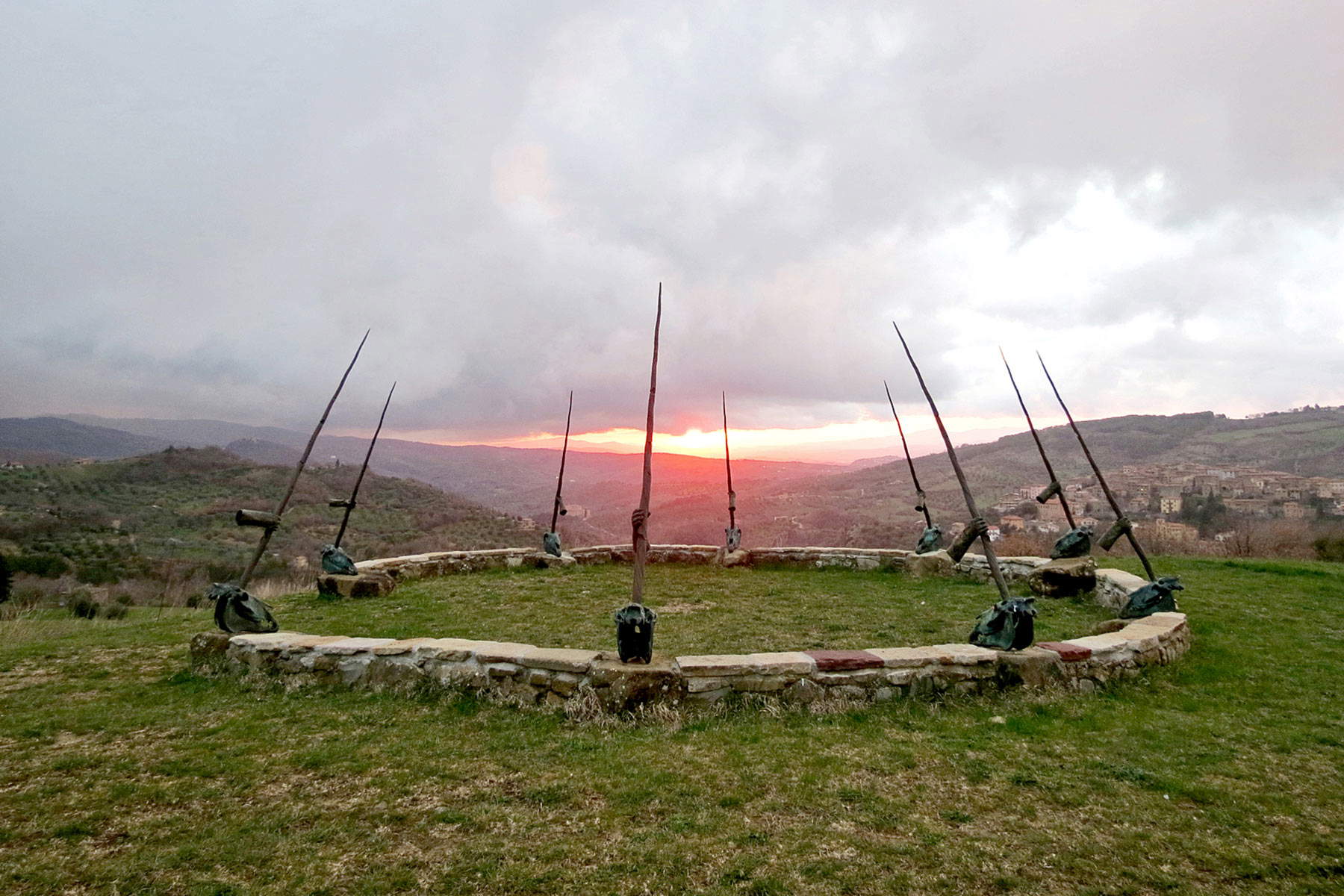 |
| The Garden of Daniel Spoerri |
2. The Tarot Garden (Capalbio, Grosseto).
Those who visit the Tarot Garden in Capalbio have the impression that they are at the famous Park Güell in Barcelona, one of Antoni GaudÃ’s masterpieces: and in fact, the artist who created the Grosseto park, the Frenchwoman Niki de Saint-Phalle (Catherine Marie-Agnès de Saint Phalle; Neuilly-sur-Seine, 1930 - San Diego, 2002), during a trip to Barcelona in 1955 was strongly fascinated by the great Catalan park itself, and after the visit made the decision to open her own sculpture garden. It was not until the 1970s that the dream took shape: in 1974, Niki had met collector and designer Marella Caracciolo di Castagneto, wife of Gianni Agnelli, in Sankt-Moritz, Switzerland, and exposed the project to her. Marella’s brothers, Carlo and Caracciolo, who were strongly interested, made the land in Capalbio available to her to begin shaping the Tarot Garden, where work began in 1979 and occupied the artist for two decades, since the Tarot Garden was opened to the public in 1998. Today, the Garden contains sculptures, between twelve and fifteen meters tall, depicting the major arcana of the tarot (hence the name of the garden). They are unmistakable works: large silhouettes filled with mosaic tiles, colorful glass and mirrors, typical of the artist’s style. For information about the park, the site to visit is www.ilgiardinodeitarocchi.it.
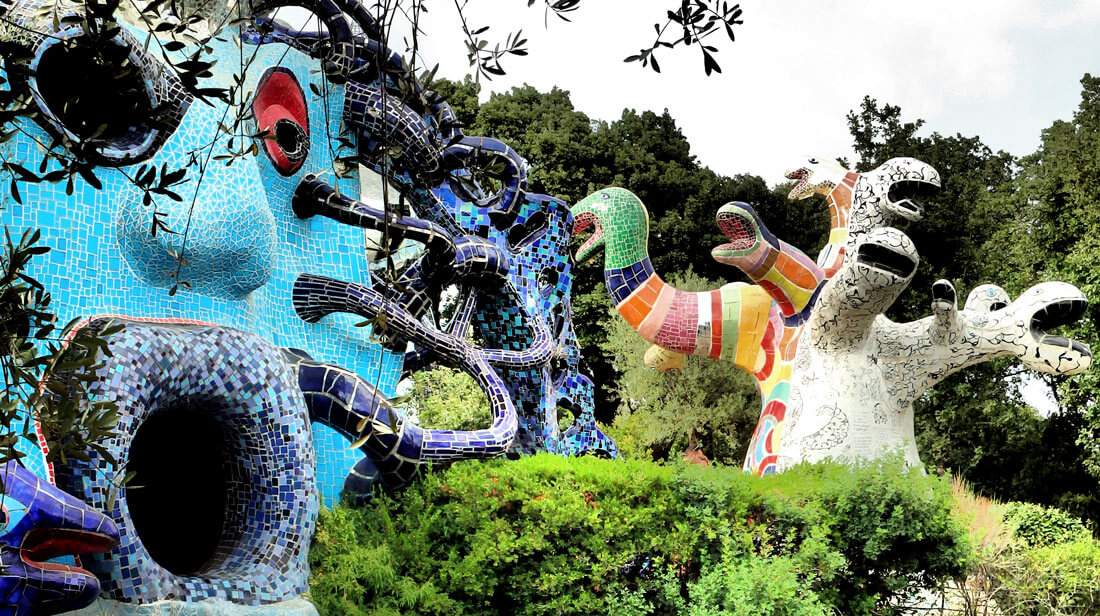 |
| The Tarot Garden |
3. Quinto Martini Park-Museum (Seano, Prato).
It is located just a few kilometers from the center of Prato, in the hills of Tuscany, in Seano, a small and quiet residential hamlet of Carmignano. It is a beautiful garden that houses the sculptures of Quinto Martini (Seano, 1908 - 1990), an artist and poet capable of blending the instances of late 19th- and early 20th-century French art (Cézanne and Degas especially fascinated him) with suggestions derived from a personal reading of Etruscan art: his works have been exhibited several times at various editions of the Venice Biennale and the Rome Quadrennial, and thirty-six of them, all in bronze and cast between 1931 and 1988, are now located in the Quinto Martini Park-Museum in Seano. The sculptures, centered mainly on the human figure, dialogue with the surrounding landscape with great naturalness, to give even the visitor that sense of fusion between culture, work, leisure and landscape that has always characterized the way Tuscans relate to life. The park covers an area of 31,530 square meters and was designed by architect Ettore Chelazzi: it is one of the most important examples of 20th-century art in Tuscany. The park is open 24 hours a day, and for more information you can visit the Carmignano Municipality website or the site dedicated to the artist.
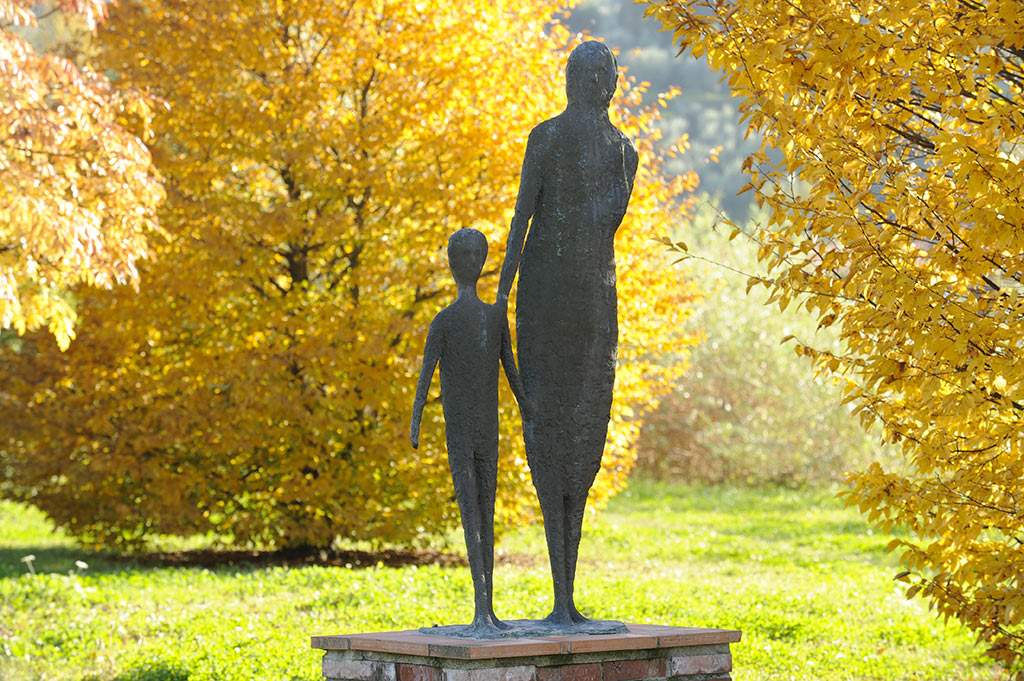 |
| Quinto Martini Park-Museum |
4. The Garden of Kurt Laurenz Metzler (Monticiano, Siena).
Located in the hamlet of Jesa in Monticiano (in the province of Siena), this is the project of Swiss sculptor Kurt Laurenz Metzler (Balgach, 1941), opened in 1995 thanks in part to the efforts of the artist’s wife, Claudia, and critic Enrico Crispolti: the garden houses many of the colorful human figures that the artist creates with different materials (from iron to bronze, marble to aluminum, and resins). They are figures created with the intention of being placed outdoors, and unlike other parks, here there is no dialogue with the surrounding space, but rather a kind of “occupation,” and the natural landscape thus becomes the stage for these figures caught in normal, spontaneous attitudes: there are those who stroll, those who chat, those who read the newspaper. What Metzler stages at Monticiano, Crispolti wrote, is “a street theater, to give an emblematically disalienating image of modern-day man.” The park can be visited by appointment; for information e-mail giardinokurtlaurenzmetzler@ymail.com, or call 0577 758130 or 335 6578362.
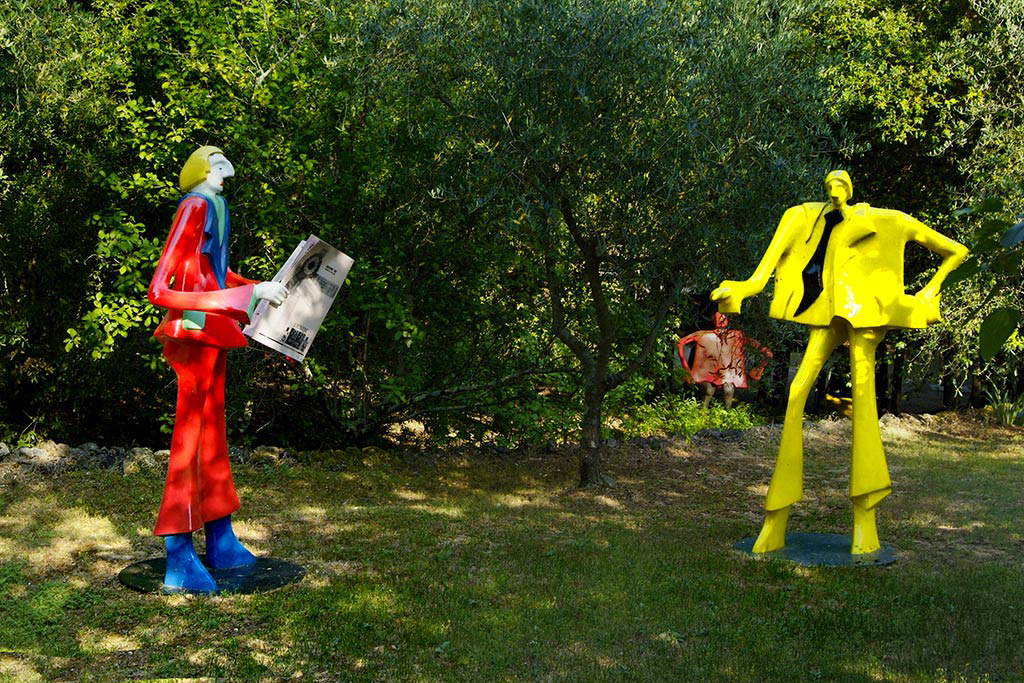 |
| The Garden of Kurt Laurenz Metzler |
5. Selva di Sogno - Dreamwoods (Casole d’Elsa, Siena)
This park with an evocative name gives substance to the dream of German sculptor Deva Manfredo, who wanted to give life to a Land Art project in Casole d’Elsa, on which she has been continuing to work for about thirty years. It is a kind of enchanted forest with a peculiarity: all the works in it are made of stone. One can find human figures, natural figures, stone games, temples, carpets of a thousand colors, and characters hidden among the trees, in the oak forest where Manfredo made his “dream forest.” In all, there are more than 150 works, all built with unworked and simply juxtaposed stones (some works are even large in size). One of the oldest materials to spur visitors to reflect on the contemporary world: this is perhaps how we could sum up the meaning of this project. “Here,” says the artist, “only one thing happens: I compose stones, put them from horizontal to vertical together and lay them, without binding or cementing them, without cutting or breaking them. I compose free and spontaneous. I work only with balance and gravity. The stones are individually chosen with care. Stones are perfect, as they are, when I find them and do not have to be carved. Stones are solid, silent, very old, patient, passive and defenseless. Nature possesses an incredible multitude and individuality in its creative expressions. Nature, the stones will live much longer than us, as they have survived a thousand generations of men. They have been, are and will be there. They are the oldest material in the world, the bones of the earth.” Information about the park can be found on the artist’s website.
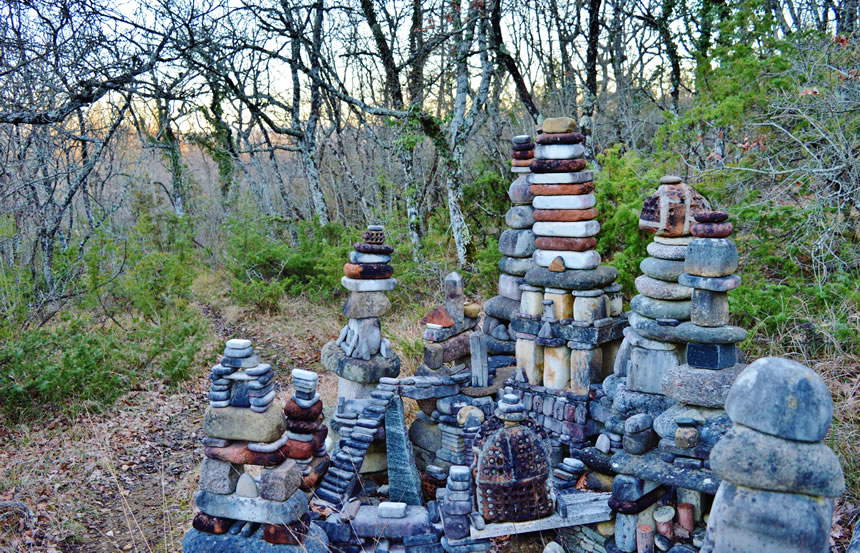 |
| Forest of Dream - Dreamwoods |
6. Jean Michel Folon at the Rose Garden (Florence).
The Rose Garden is not a recent project: in fact, it was opened in 1865 as part of the renewal of Florence, which had recently become the capital of Italy. What is new is the intervention of Belgian artist Jean Michel Folon (Uccle, 1934 - Monaco, 2005), who has given new meaning to this space, opened in the magnificent complex of Piazzale Michelangel. Descending a few meters from the most famous of Florentine panoramas, on the edge of a hairpin bend in the avenue leading toward the city, one encounters a gate leading into this city park, which, since 2005, when Folon exhibited in a solo show at Forte Belvedere, has been filled with his sculptures. The artist disappeared shortly after the conclusion of the exhibition, but he had made time to express his desire to leave a trace of himself in Florence: thus, thanks to the willingness of his widow Paola Ghiringhelli, some of his sculptures made between the 1990s and the extreme stages of his career, donated to the City of Florence, have found space in the garden designed by Giuseppe Poggi. These are nine bronzes and two plaster casts, which now act somewhat as “companions” to the traveler or citizen who decides to stop and see Florence from above. Famous is the sculpture Partir, part suitcase and part frame that encloses the sumptuous picture that is the Tuscan capital.
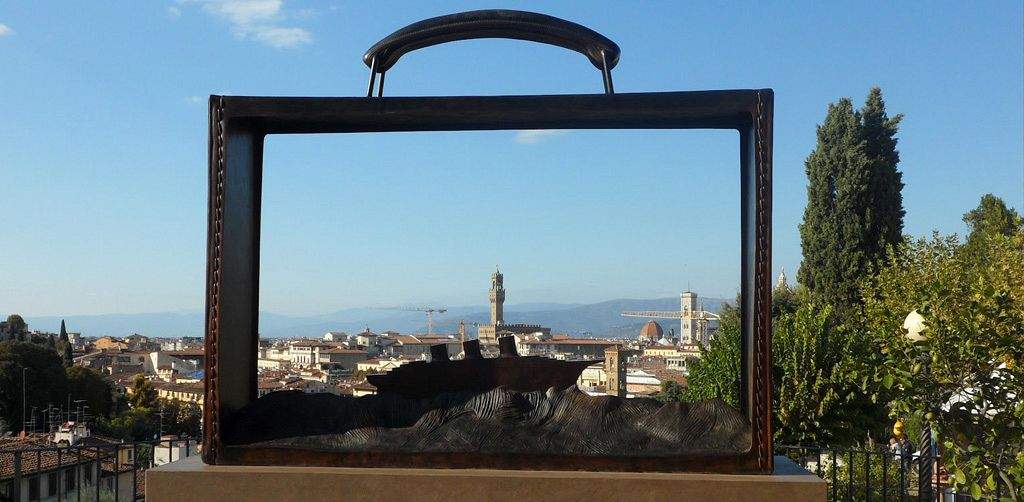 |
| Jean Michel Folon at the Rose Garden |
7. Open Air Museo Italo Bolano (Portoferraio, Livorno).
The Open Air Museo is a project by artist Italo Bolano (Portoferraio, 1936), created in 1965 on the island of Elba, Portoferraio. It was opened under the name International Art Center, a title now reserved for a section of the project, which has since been enriched and has become a large park of ten thousand square meters where thirty ceramic monuments and various plants typical of Mediterranean vegetation are located. Bolano’s idea was to create a large international museum of contemporary art, which then took the form of a kind of inner garden, with which the artist gives shape to his thoughts through the medium of ceramics. The museum today houses spaces for temporary exhibitions, lecture halls, educational workshops centered mainly on ceramic work, there is an open-air theater and houses a bookshop. The Open Air Museo, by the artist’s own will, is constantly enriching: for Bolano, in fact, the museum wants to be an endless construction site capable of developing in a non-programmatic way, but according to inspiration, inspiration, and creativity. For more information about the park-museum, you can visit Italo Bolano’s website.
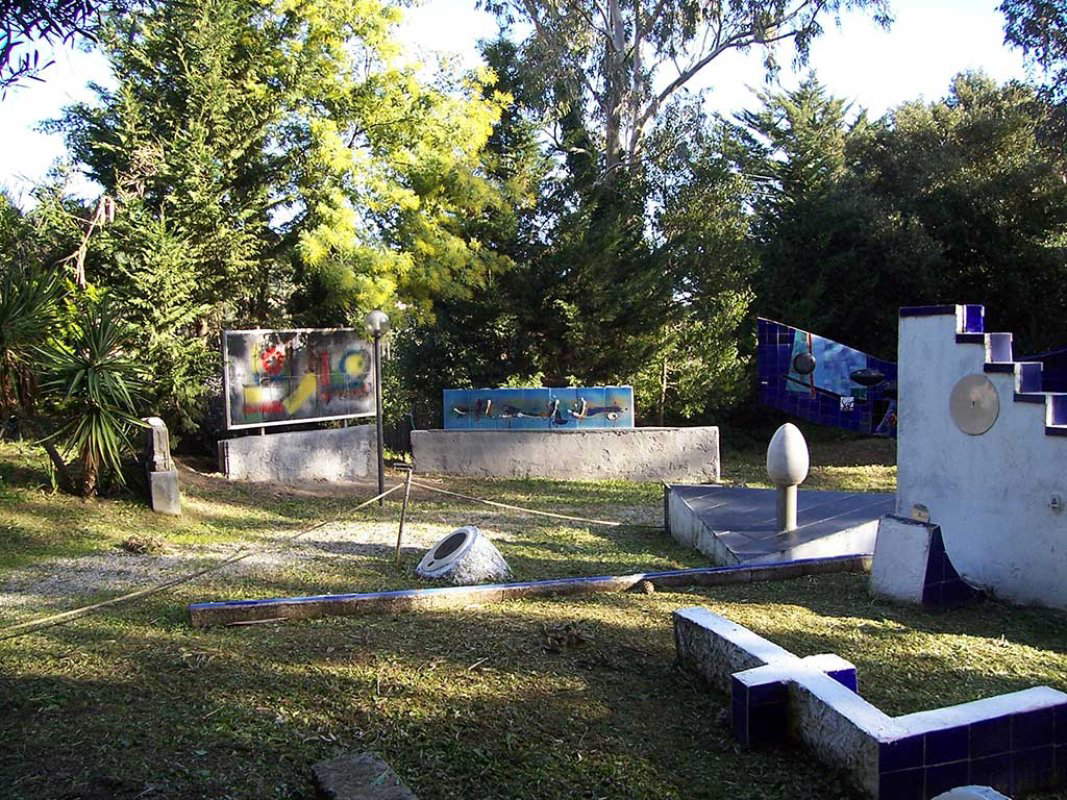 |
| Open Air Museum Italo Bolano |
8. The Garden of Sounds (Montieri, Grosseto).
This park is located in Montieri, not far from Massa Marittima, in the Maremma region of Grosseto, and is the work of Bavarian artist Paul Fuchs (b. 1936), who has created a garden of stone, wood and iron sculptures on his land since 1996, some of them of enormous size (such as the Great Iron Indicator, 31 meters high). The works are set in a forest to create an intense dialogue between nature and sculpture: in fact, the works themselves frequently recall natural elements. The park’s name comes from the fact that some of the sculptures are so slender that, when the wind blows, they rise into the air, giving rise to a kind of delicate symphony. The Garden of Sounds, which occupies a two-hectare space, is a constantly evolving work, and can be visited by appointment. Information is available by calling 0566 998221, emailing paul.fuchs@tiscalinet.it, or visiting the artist’s website.
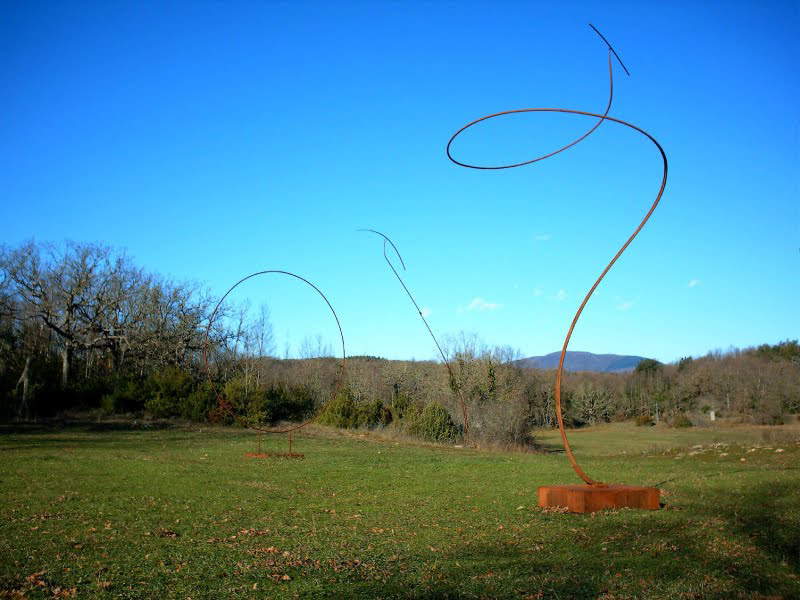 |
| The Garden of Sounds |
9. “Journey Back” Garden (Castiglione della Pescaia, Grosseto).
This is the project of bioarchitect Rodolfo Lacquaniti, located on the “il Leccio” farm in Buriano, a few kilometers from the center of Castiglione della Pescaia. The garden’s name derives from the fact that all the works here are made from waste or recycled materials, a typical feature of Lacquaniti’s poetics: the idea is to give new meaning to objects that the production cycle has excluded from the common concept of value. Here, the opposite happens: what is considered to be of little value is the basis with which evocative works of art are created. With the idea of inviting all people who visit it to reflect on the great ecological issues of today’s world: the finiteness of resources, the recovery and recycling of materials, and respect for the planet. To learn more about this extraordinary garden (which is also an educational center that often hosts themed workshops), you can visit the artist’s website.
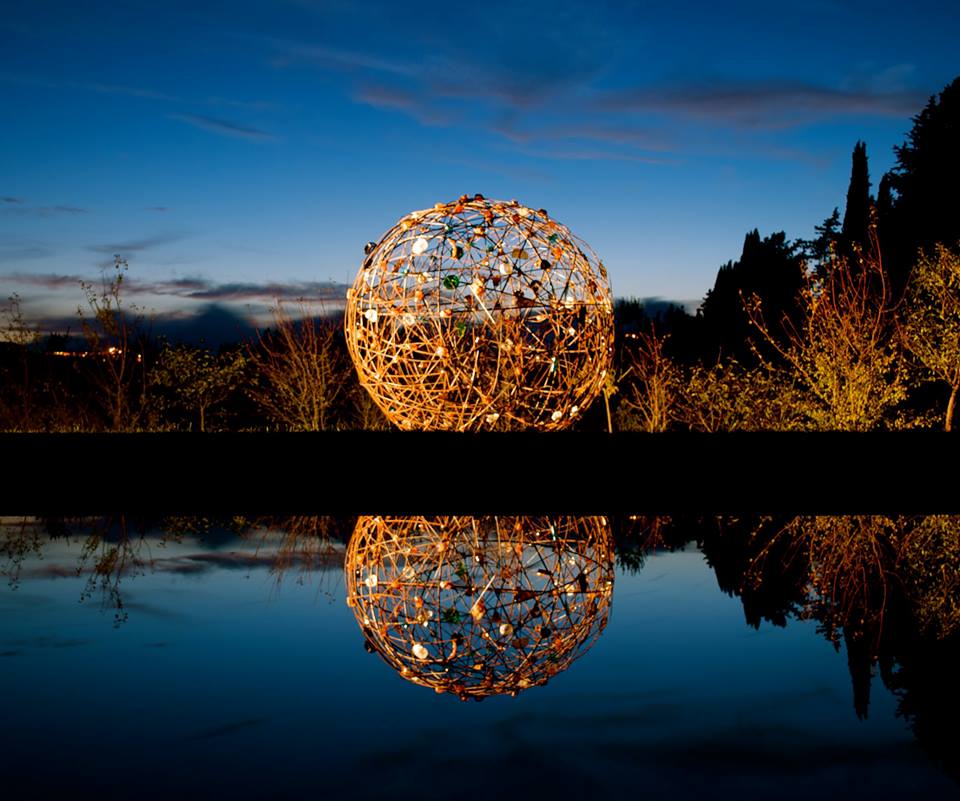 |
| Garden Return Journey |
10. Site Transitoire (Asciano, Siena)
It is not a real park, but it is a Land Art intervention that, since 1993, has characterized this piece of landscape in the Crete Senesi near Asciano, not far from Siena. It is a large Etruscan basalt stone sculpture created by French sculptor Jean-Paul Philippe (Altfortville, 1944), who lives and works between Paris and Siena. “A few years ago,” said the artist about this work, "a thought completely occupied my time, to make in stone and put in space three familiar positions: sitting, standing up, lying down, and leave them silent to converse with each other in the solitude and silence of a natural place. I could never have imagined that what was about to become the Site Transitoire would be complicit in so many encounters. The place chosen was that: a hill between Siena and Asciano in the heart of the Crete Senesi, between Leonina and Mucigliani. Making that gesture, installing those stones, I realized that they drew in light and space the limits of a house. A dwelling without walls with an invisible threshold. On the ground some slabs, a chair to welcome the passerby, a bench, a window, and for a roof the vault of heaven. The shadow of this stone furniture traced its walk on the ground thanks to the appearances of the Moon and the Sun. On the summer solstice it is in the flattening of the window that the solar disk disappears, while the first star and the lights of Siena shine." The work was conceived by the artist with the clear intention of relating to the landscape around him. The installation can be visited anytime, any day of the year, being in an open natural setting.
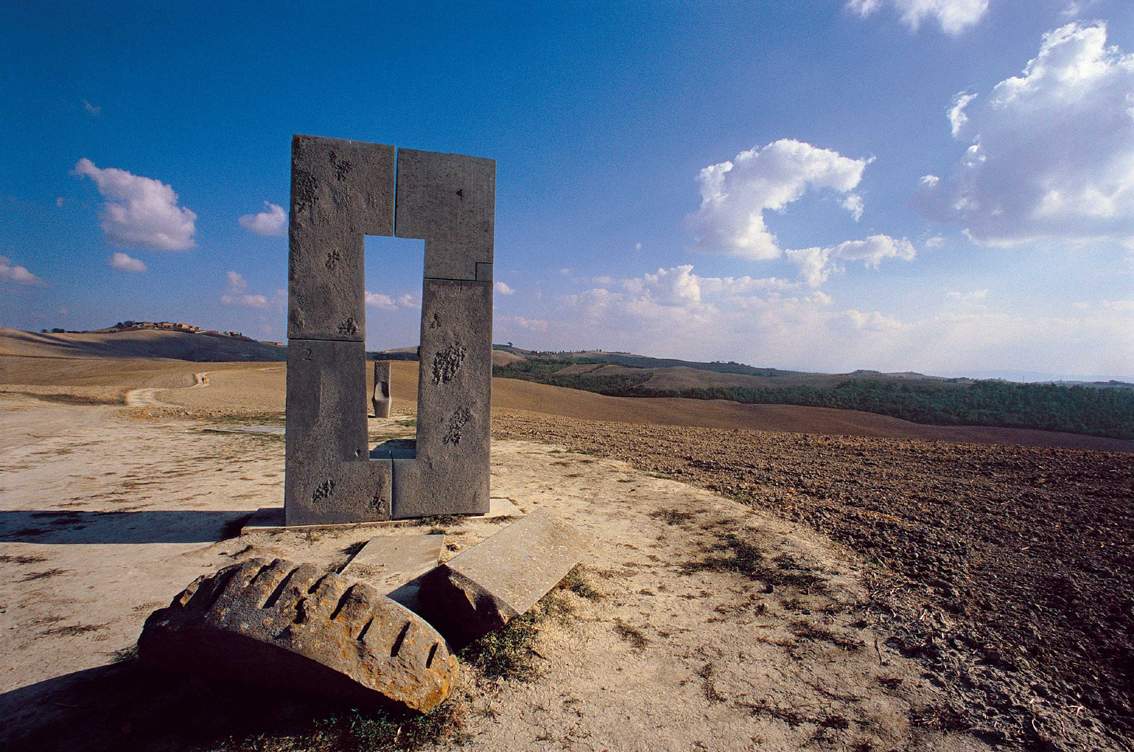 |
| Site Transitoire |
 |
| 10 beautiful artist parks to visit in Tuscany |
Warning: the translation into English of the original Italian article was created using automatic tools. We undertake to review all articles, but we do not guarantee the total absence of inaccuracies in the translation due to the program. You can find the original by clicking on the ITA button. If you find any mistake,please contact us.





























